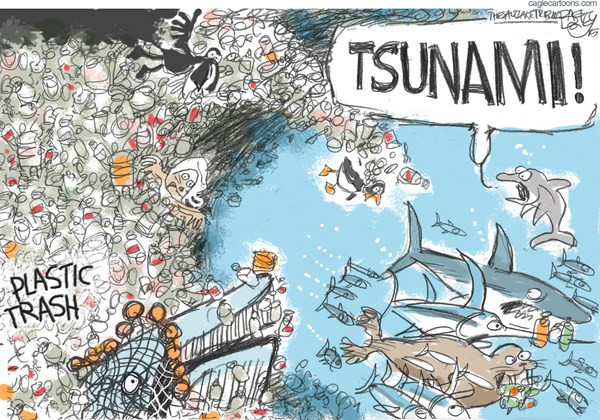The Humble Plastic Straw
Removing It from the Ecosystem Could Avert Catastrophe

Next year will be the year of plastic straw bans. Beginning July 1, 2019, Santa Barbara’s ordinance will make it unlawful for any beverage or food provider to give customers plastic straws (or plastic stirrers. Plastic cutlery may be given “upon request”). Under the ban for the State of California, which takes effect January 1, customers may ask for a plastic straw at fast-food restaurants (where the bulk of the straws are actually provided), coffee shops, and take-out restaurants, being exempt from state law.
With these kinds of exemptions and limitations, it is reasonable to ask, why bother? The answer is straight forward. Plastic trash has become the environmental scourge of our time. The U.S. Environmental Protection Agency (EPA) estimates that last year more than 33 million tons of plastic, most of which was not recycled, was thrown away by Americans. Worldwide the amount is staggering: 6.9 billion tons of plastic became trash last year, with 6.3 billion tons not recycled. Rather than nitpick the limitations of the bans, we should view them akin to having to ask for a glass of water during extreme drought — a window into something far larger than just a plastic straw.
Plastics are ubiquitous in modern society. They have transformed our lives. They’ve revolutionized medicine and lightened cars and jet aircraft, saving fuel and pollution. Plastics extend the life of food, deliver drinking water to poor people without water distribution systems, and more. These are all really good, important things. On the other hand, single-use plastics (bags, bottles, containers, cutlery, stirrers, and straws) are devastating the environment.
While we’ve all seen photos of mountains of plastic trash piled high in third-world countries, most of us are not aware that the majority of discarded plastic winds up in landfills and the ocean. In landfills, depending on liners, plastics can leak pollutants into soil and water tables, and take up to 500 years to decompose. In the ocean, where it does not biodegrade, it has begun to threaten the vitality of one of Earth’s most necessary ecosystems.
Oceans cover more than 70 percent of the planet. They carry about 50 percent of global production of photosynthesis and support the greatest biodiversity on Earth. They are the “lungs of the planet.” Oceans hold up to 54 times more carbon than the atmosphere, and the vast bodies of water drive both climate and weather systems. They supply food for the world (about a billion people rely on fish as their main source of protein) and provide huge economies for fisheries, tourism and recreation. Life on Earth is unimaginable without our oceans. They are now, worldwide, being threatened by plastic pollution.
It’s estimated that 165 million tons of plastic debris are now floating around all of our oceans with an average of approximately 8 million more tons entering the oceans annually. This includes microplastics, tiny particles less than five millimeters long, routinely ingested by fish and marine mammals. According to scientific consensus, at current rates of disposal, there will be more plastic in the ocean than fish by 2050.
This kind of marine degradation threatens ecosystems, impacts human health and destroys sea life.
Ocean ecosystems (coral reefs, kelp beds, the sea floor, intertidal zones, estuaries, lagoons, the deep sea) are under siege from climate change, overfishing, acidification, habitat degradation, and pollution. Plastic pollution releases hazardous materials which in turn reduce oxygen in these ecosystems, further threatening the diversity of life dependent upon them. Plastic garbage in the ocean brings with it the invasion of non-indigenous species and organisms that literally ride the debris and attack ecosystem vitality. And then there are the Gyres.
Much of the plastic waste is carried by currents into one of five ocean regions forming swirling formations of plastic Garbage Patches, i.e., Gyres. These are The Great Pacific Gyre, the North Atlantic Gyre, the South Atlantic Gyre, the South Pacific Gyre, and the Indian Ocean Gyre. One should not be confused by the name “Patch,” these are massive concentrations of plastics. The one between California and Hawaii, is twice the size of Texas. Only 5 percent of these massive concentrations is on the surface; the rest have sunk into the water column and to the bottom of the sea, polluting marine ecosystems and threatening a myriad of species.
Plastics in the ocean threaten human health. Plastics contain toxins linked to cancers, birth defects, immune system problems, and child development issues. These toxins (lead, cadmium, mercury, and diethylhexyl phthalate (DEHP), a known carcinogen), are passing through the food chain to humans who eat seafood. Indeed, a recent study found that a quarter of fish in markets in California contained plastic microfibers.
Fish in the North Pacific ingest 12,000 to 24,000 tons of plastic each year, which cause intestinal injury and death and transfer plastics up the food chain. Half of sea turtles worldwide have ingested plastic. They mistake floating plastic garbage for food. They choke, sustain internal injury, and die, or starve by thinking they’re full from eating plastic.
Seabirds ingest plastic. Plastic ingestion reduces the storage volume of their stomachs, causing starvation. It’s estimated that 60 percent of all seabird species have eaten pieces of plastic, with that number predicted to increase to 99 percent by 2050. Marine mammals also ingest and get tangled up in plastic, leading to the decline of already endangered pinnipeds like monk seals and stellar sea lions. Dead whales have been found with bellies full of plastic.
So, this brings us back to plastic straws. Its estimated Americans use and throw away approximately 172 million plastic straws a day. These non-biodegradable, petroleum-based products all too often wind up in local waterways, on beaches, and in the ocean. Plastic straws made the top 10 items picked up on beach cleanups worldwide. The arguments in favor of banning them? Plastic is not biodegradable, once discarded it will never be gone from the Earth, and it is adding to the destruction of our oceans.
An ultimate solution to this environmental catastrophe will require government action. Laws should limit plastic use, improve waste collection infrastructure, and expand recycling. Until then, we should support one-way plastic bans like bags and straws, and each do our part by reducing plastic use.



